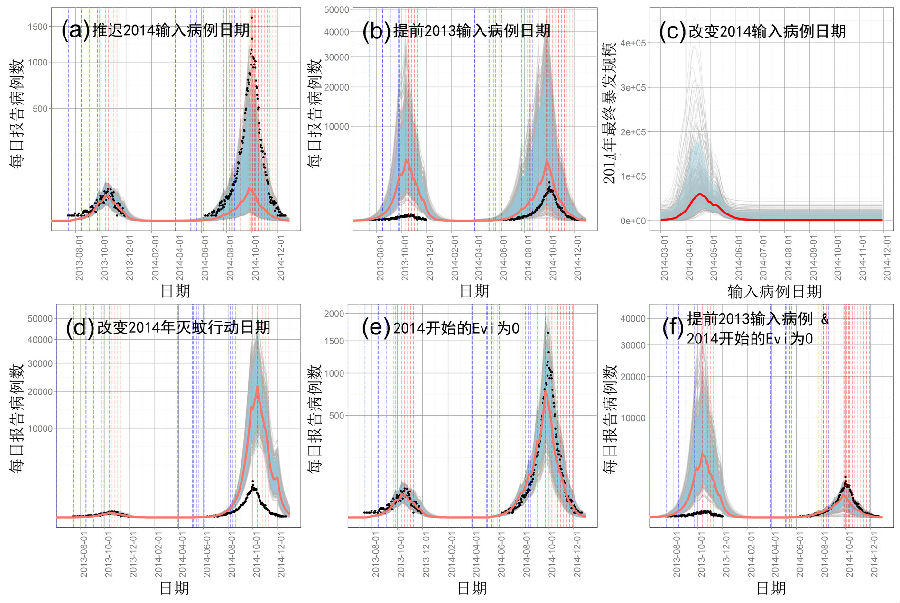Recently, CESS Ph.D candidate Cheng Qu published a paper as the first author called”Climate and the Timing of Imported Cases as Determinants of the Dengue Outbreak in Guangzhou, 2014: Evidence from a Mathematical Model” on the journal ofPLOS Neglected Tropical Diseases. And Professor Gong Peng is the corresponding author. The co-authors include Archiater Yang Zhicong and Jing Qinlong in Department of Infectious Diseases, Guangzhou Center for Disease Control and Professor Robert C. Spear and Associate Professor John M. Marshall in University of California, Berkeley.

Trajectories of daily new cases under different scenarios.(A) Postponing the date of imported case in 2014; (B) advancing the date of imported case in 2013; (C) setting the intervention in 2014 to the same as that in 2013; (D) removing all the infected eggs at the beginning of 2014; (E) advancing the date of imported case in 2013 and removing all the infected eggs at the beginning of 2014; and (F) trajectories of the final epidemic size for 2014 after changing the date of imported case between March 1st and November 30th. Black dots indicate for the daily reported case in 2013 and 2014. Gray lines indicate the trajectories for each simulation. Red lines indicate for the median and blue shaded area for the 90 percent interval for all 637 simulations.
As the world’s fastest spreading vector-borne disease, dengue was estimated to infect more than 390 million people in 2010, a 30-fold increase in the past half century. Although considered to be a non-endemic country, mainland China had 55,114 reported dengue cases from 2005 to 2014, of which 47,056 occurred in 2014. Furthermore, 94% of the indigenous cases in this time period were reported in Guangdong Province, 83% of which were in Guangzhou City. In order to determine the possible determinants of the unprecedented outbreak in 2014, a population-based deterministic model was developed to describe dengue transmission dynamics in Guangzhou. Regional sensitivity analysis (RSA) was adopted to calibrate the model and entomological surveillance data was used to validate the mosquito submodel. Different scenarios were created to investigate the roles of the timing of an imported case, climate, vertical transmission from mosquitoes to their offspring, and intervention. The results suggested that an early imported case was the most important factor in determining the 2014 outbreak characteristics. Precipitation and temperature can also change the transmission dynamics. Extraordinary high precipitation in May and August, 2014 appears to have increased vector abundance. Considering the relatively small number of cases in 2013, the effect of vertical transmission was less important. The earlier and more frequent intervention in 2014 also appeared to be effective. If the intervention in 2014 was the same as that in 2013, the outbreak size may have been over an order of magnitude higher than the observed number of new cases in 2014.The early date of the first imported and locally transmitted case was largely responsible for the outbreak in 2014, but it was influenced by intervention, climate and vertical transmission. Early detection and response to imported cases in the spring and early summer is crucial to avoid large outbreaks in the future.
According to Thomson Reuters Citation report in 2014, the impact factor ofRemote Sensing of Environmentis 4.446.
Paper link
Cheng Q, Jing Q, Spear RC, Marshall JM, Yang Z, Gong P (2016) Climate and the Timing of Imported Cases as Determinants of the Dengue Outbreak in Guangzhou, 2014: Evidence from a Mathematical Model. PLoS Negl Trop Dis 10(2): e0004417. doi:10.1371/journal.pntd.0004417
http://journals.plos.org/plosntds/article?id=10.1371/journal.pntd.0004417